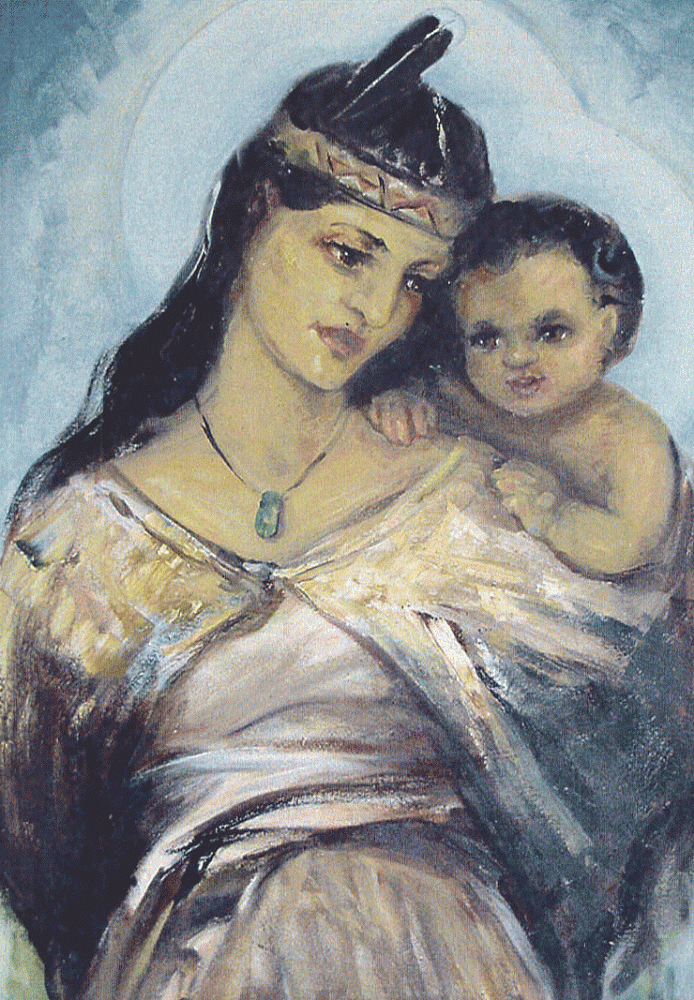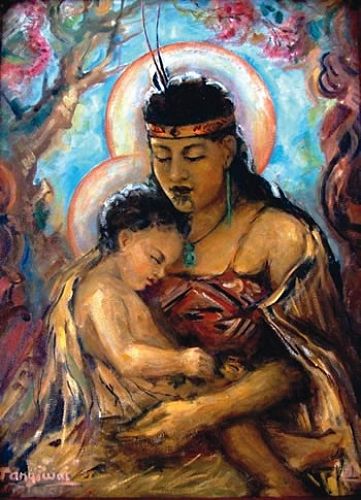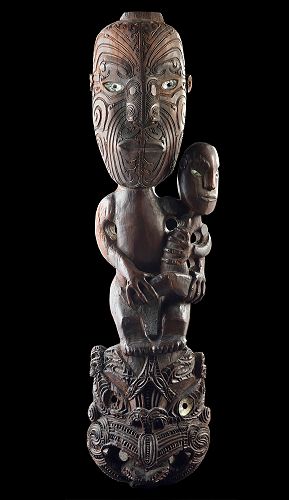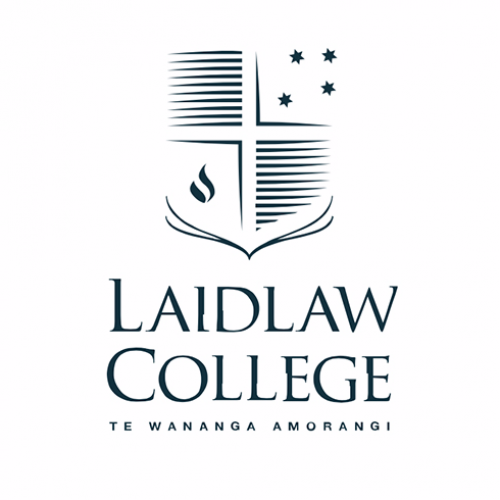
Te Kahurangi o Māhutonga
Southern Madonna [fig.1] is a representation of Mary and her child Jesus depicted as Māori people, or tāngata whenua of Aotearoa New Zealand. The image is located at Southern Star Abbey, a Cistercian monastery in Kopua, Central Hawke’s Bay.
When I first saw this painting in the early summer of 2016, a chance encounter during a visit to the monastery, I was touched by the beauty of the wahine and the position of her tamahou. Yet it wasn’t until I returned to the monastery in the Spring of 2017 that I began to appreciate the painting’s deeper meaning.
By extracting traditional Māori motifs to reference an authentically Catholic theme, the artist of Southern Madonna, Julia Bridget Lynch (Sister Mary Lawrence, RSM), has for me transcended race and moved beyond religion, all the while rendering a most respectful representation of Aotearoa New Zealand’s host culture. Mary is Te Kahurangi o Māhutonga. She wears a Māori face, and dons a simple korowai, tipare, heru, and pekapeka made of tangiwai pounamu. Although Southern Madonna, like other Pākehā versions of the Madonna and Child such as Tangiwai in which Mary has a moko kauae [fig.3], may not hold the mana of te ata āhua Māori as does the tekoteko, an Ariki Tapairu portraying Mary with full-face moko [fig.2], though still this painting raises serious questions for me about meaningful relationships: Is the Māori Mary and Jesus for the tāngata whenua only? Or, am I included in that tāngata? Does the tāngata imply all the people of the land of Aotearoa New Zealand, or just the Māori? I was a great-grandson of English and Irish immigrants to Aotearoa New Zealand, a Pākehā and a Christian, so who are the Māori Mary and Jesus for me?
Artistic representation has its own normative truth, a kind of “signatured truth” not unlike the truth of religion or sacred scripture. In representational art, a depiction of Mary or Jesus as Māori says more than “Mary is Māori” or “Jesus is o te whenua (of the land).” In fact, it doesn’t say that at all. Everyone knows that the mother of Jesus was not ethnically a Māori woman, and that Jesus was a Jew. The subjective assignment of race to religious figures is not a racial issue in the iconography of the Christian tradition. It is a devotional practice which has been around for centuries.[1] In ancient times it was used to establish familiarity. Host cultures that adapted Christianity often used local ethnic characteristics to code Jesus and Mary, and Christianity often adapted its religious images in ways familiar to indigenous peoples.[2] The Māori are no exception. Today, however, in a multicultural society, this practice moves beyond ethnic familiarity to create a sense of religious unity. For me, this is achieved in Southern Madonna by an ocular detail which I think makes the painting quite unique.[3] I’ll explain this specific detail shortly .
Meanwhile, the monastery was my home for a week that Spring. I saw Southern Madonna about seven times a day, at Vigils, Lauds, Mass, Sext, None, Vespers, and Compline. The painting hung in the church, on the right side of the tabernacle. I like how it invites Māori into the Christian mystery on their own terms, and allowed viewers to ponder the meaning of religio-cultural convergence.[4] For me, while I appreciate that the Madonna and Child message can be translated into any culture, Southern Madonna creates an intensely personal and transformative experience. It goes beyond mother-to-child and mother/child-to-viewer relationships to crystallise Māori-to-Pākehā and Catholic-to-Māori through the lens of a Pākehā. Because I am a Pākehā, it offers me a spiritual comfort that I have never encountered before. Māori Mary, as Lynch interprets her, is my mother too not by virtue of the Christian faith alone, but because she is Ko te whaea o te tāngata whenua. Even more, she is in a sense te whaea o te ao, the universal mother for Catholics. As a Pākehā New Zealander, I feel that mother Mary as a Māori woman authenticates my right to belong as manuhiri, united in faith despite racial distinction. The woman’s motherhood is extended to me through a spiritual bloodline because we have the same Atua matua. We are spiritually whakaminenga. This extension creates a kind of spiritual whakapapa through which I become part of Mary and Jesus’s whānau. This transforms my whakapapa by spiritualising my sense of family belonging. It moves me beyond the limitations of my human whakapapa to embrace a wider whānau. I feel as if Māori Mary and me, together with her child, the monks, their manuhiri, and the artist are all whakaminenga, a whānau o te Atua. As the monks prayed during the ninth hour, “how good and how pleasant it is, when God’s people live in unity” (Psalm 133).
The longer I reflected upon the Southern Madonna, the more convinced I was that the artist has created something more meaningful than just another Māori Madonna. This was probably due to that ocular detail mentioned earlier. Each time I saw Southern Madonna, my attention quickly moved to the child, and to his gaze. He isn’t the typical baby Jesus seen in traditional Madonna and Child depictions, though he is strikingly familiar; that wide-eyed, spry and playful tamaiti seen almost every day in the playgrounds of Aotearoa New Zealand. He isn’t really a tamahou because he was already too old, yet he is on his mother’s back, looking out over her shoulder. The way he gazes from behind his mother intrigues me. Rather than seeing me, he looks out at something immediately in front of me. At first, this bothered me. I felt a sense of my unworthiness as I wanted him to see me. Though I knew that if this Jesus wasn’t seeing me, then he wasn’t seeing any viewer. This detail challenged me to reassess how my personal situation requires a renewed relationship with the wider community. By offering me the opportunity to acknowledge and accept a Māori mother as my matua, it makes me feel that Jesus would then see me as his teina. This made me think about every tamaiti as my brother, which sparked the beginning of a renewed relationship by linking me with our common tupuna and Atua matua. For me, this linkage helps to overcome my vulnerable feelings of estrangement by establishing relationship and communion. It links me in what Māori call whanaungatanga.
While I am not sure how much of this interpretation is a result of my theological training, or how much is actually part of the image’s meaning made visible, nevertheless, for me, Southern Madonna is more than a cultural statement. It is a picture that inspires a spiritual family unity. It challenges me to overcome my feelings of separateness and it invites me to belong to the wider community. This means acceptance of cultural difference and closeness of human relationship. It provides me with a new competence to handle my cultural impulses, as well as the cultural impulses of my whenua. In this sense, Southern Madonna offers mediation, reconciliation, and communion. I have been deeply touched by this image. I found in it the taonga of tikanga united with genuine Christian values and a sense of belonging.
While at the monastery, I also learnt that Mary plays an important role in the spiritual life of the monks at Kopua. The monastery is dedicated to her under the title of “Our Lady of the Southern Star.” This title derives from a constellation in the Milky Way galaxy, visible in the southern hemisphere sky. The constellation was named Southern Cross by sixteenth-century European explorers who recognised in it the shape of a cross – four bright stars as outline, and a fainter star below the crossbar. The Māori term is Māhutonga. The star at the foot of the cross is, presumably, the southern star, which by analogy is Mary, since Mary stood near the foot of Jesus’s cross as the Gospel of John recounts (John 19:25). Thus, the title of the painting “Southern Madonna.” Added to this imagery is the star’s blue-tinged light and brightness, qualities further symbolising Mary. When I gazed at the star in the southern sky, I was inspired, though when I see Southern Madonna at the Kopua monastery it is aroha, a term used by Māori to describe the principle governing relationships among Atua, tangata and whenua, and commonly called love. Māori priest Henare Arekatera Tate defines aroha as a principle that “creates, celebrates or renews the communion of tapu.”[5]
As my time at the monastery ended, the significance of Southern Madonna became clearer to me. This painting renders aspects of te ao Māori present to all viewers, and in this sense, the wahine and her tamaiti are familiar to both tāngata whenua and to Christians. I felt that through her, Māori and Pākehā Christians were no longer substantially distinct. We were both part of the greater whānau o te Atua.
Further to her role in the spiritual life of all at the monastery, each evening as the monks close their day, the last greeting before the Grand Silence is given to the Southern Madonna, as if she were present with them and their guests, inextricably connected with her spiritual whanau. Through this whanaungatanga, all present unite not only with each other, but on account of her, with the entire tāngata whenua.
Meanwhile, although I have left the Kopua monastery, I often return to Southern Madonna because I now carry her with me. She is the home-screen on my cell-phone. Sad perhaps, nevertheless, she is also frequently on my mind.
Christopher Longhurst lectures at Te Pūtahi Katorika ki Aotearoa (The Catholic Institute of Aotearoa New Zealand). His academic specialty is the interdisciplinary study of theology and aesthetics. He has taught at Victoria University of Wellington, Al Akhawayn University in Ifrane, Morocco, and Marymount International Institute, Rome, Italy. Chris also works as an operatore didattico (educational officer) at the Vatican Museums, Rome.
[1] The earliest representation of the Madonna and Child may be a wall painting in the Catacomb of Priscilla, Rome, 3rd century CE, where Mary appears as a Roman matron. Cf. Victor Lasareff, “Studies in the Iconography of the Virgin,” in The Art Bulletin 20.1 (March 1938), 26-65.
[2] Ethnically coded Mary and Jesus images falls under the practice of inculturation and Catholic popular piety in which the figures take on race, clothes, and styles of local culture as part of a gentle evangelization. In cases depicting the Madonna and Child, these images are commonly described as “inculturated Madonnas.” Many versions exist. One of the most well-known is Our Lady of Guadalupe. Other examples are Madonna and Child of Soweto, Mary and Jesus in Persian miniature, and the Hopi Madonna and Child. Cf. Cheryl D. Edwards, Inculturated Madonna II (2013), US Arts, http://www.us-arts.de/Artists/Edwards-Cheryl-D/CHERYL-D-EDWARDS-Inculturated-Madonna-II-Original::71.html?language=en. See also Mary Fong, and Rueyling Chuang, eds., Communicating Ethnic and Cultural Identity (Rowman and Littlefied, 2003), 114.
[3] Ocular details in pictorial art concern how the eyes in human representations are used by artists to communicate relationship and directionality. In Madonna and Child scenes, the relationships involve three parties: Madonna, child and viewer in diverse relationships created by details such as child looking at Madonna, who looks at viewer; Madonna, looking at child who looks at viewer; both Madonna and child looking at viewer, neither Madonna or child looking at viewer but looking at each other.
[4] By “religio-cultural convergence” I mean the introduction of religion into a culture, and the influence of culture on the evolution of religion.
[5] Henare Arekatera Tate, Towards Some Foundations of a Systematic Māori Theology (He tirohanga anganui ki ētahi kaupapa hōhonu mō te whakapono Māori), PhD Thesis (Melbourne: Melbourne College of Divinity, 2010), 139.
Gallery



